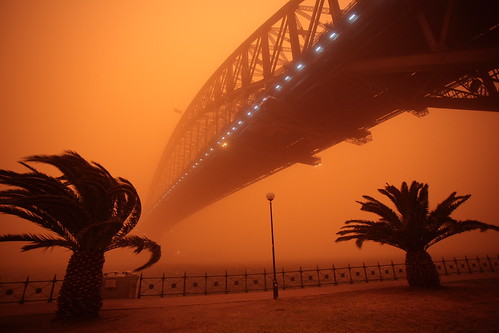Waking this morning was a very eerie experience. Blood-red light peaked through the sides of my blinds, and given I was half asleep at the time, I thought the four horsemen of the apocalypse had come to Earth.
When I shook the haziness from my head and peaked outside, the view was astonishing. Not surprisingly, Twitter had loads of comments and on-the-fly photos, and the TV and radio news broadcasts were full of dust-storm stories.
Dust storms are not uncommon in Australia - indeed, central and eastern Australia are a major global source of atmospheric dust, and this particular storm, estimated to be 600 km long and dumping 75000 tonnes of dust into the Tasman Sea every hour, could be headed to the New Zealand ski-slopes (that'll teach you to beat us at rugby). Dust can travel a very long way in the atmosphere, with dust from Chinese storms found in the French Alps.
The storm has its origins in the Indian and Southern Oceans, where low pressure storms create severe cold fronts. Low pressure air sinks to the ground, forcing hotter, higher pressure air upwards. This can cause thunderstorms, and on Monday, winds of more than 100 km per hour formed in South Australia. As inland Australia is in drought, the winds picked up dust not fixed to the ground by vegetation. The dust likely came from the Lake Ayre Basin, according to ABC Science Online, and has caused the worst pollution ever seen in NSW.
The reddish colour of the sky is an interesting phenomenon. Normally during the day, the sky is blue. This is because of Rayleigh scattering. Shorter wavelength light from the Sun (blue) is scattered by the air in all directions to a greater degree than longer wavelength light (red). The amount of scattering is related to the fourth power of the wavelength - blue light with a wavelength of ~400 nm is scattered about 10 times more efficiently than red light (~ 700 nm). The scattering in this case is mainly due to oxygen and nitrogen molecules smaller than the wavelength of the light.
Due to the scattering of blue, when you look directly at the Sun, you see more of the longer wavelength light, which is why it appears yellow. The rest of the sky is lit by the diffuse scattered blue light. At dawn and dusk, the Sun's light has to travel through more of the atmosphere to get to your eyes as it comes in at a tangent to the Earth (go on, draw it...). This means even more blue is scattered and a larger piece of the sky looks a even deeper red.
Dust particles are quite large compared with oxygen and nitrogen, and so do not scatter light in the same way. Some dust absorbs light more effectively at blue wavelengths than at red wavelengths, meaning that light shone through it will appear more red. Dust also scatters sunlight, but as the particles are large, this scattering is independent of wavelength. This means that the dust particles act something like tiny mirrors, diffusing the light throughout the sky. This is why the red colour was so intense at dawn - as the light that hit the dust was already red due to Rayleigh scattering, it was then scattered throughout the whole sky. Normally at sunrise, the red colour is confined to only a small part of the sky. The presence of dust (and pollution for that matter) can cause beautiful effects. As the sun climbed higher in the sky today, the red colour softened. Eventually the sky just looked a dirty orange - the colour of the iron-rich dirt.
Here are some of my favourite pics from today - the above zombie was found through @ozdj. I received the following Godzilla pic in an email and found it on flickr, but I don't know who the originator is. It is brilliant. None of these images have been manipulated - yes, it was back to the 60s with sepia Sydney today!
From MarchingAnts on flickr:
From TomHide on flickr:
Also see the Red Dust Collection and The Red Sydney Project. More dust storms are predicted for this week, so stay tuned.
Wednesday, 23 September 2009
Subscribe to:
Post Comments (Atom)
















I like your photos and the scientific explanation of how light and wavelength produce the color spectrum, but what is Godzilla doing there? No matter what wave length you have, Godzilla won't be there unless you are halucinating:)) from too much sun exposure:))
ReplyDelete_______________________________________________
Phuket Hotels
ReplyDeleteHi there, I log on to your new stuff on a regular basis.
Your humoristic style is awesome, keep doing what you’re doing!
Take a look at my web site; 대구오피
(jk)
Find out about the negative effects of stress on the eyes. Discover natural eye care remedies to help you to relieve eye problems associated with the negative effects of stress on the eyes. https://visualaidscentre.com/service/eyes-specialist-delhi/
ReplyDeletetest
ReplyDelete가슴이 두근거리는 에볼루션카지노 에서 놀아봅시다
ReplyDeleteBest Interior & Kitchen Design Firm in Islamabad
ReplyDeleteHello mmate nice blog
ReplyDelete